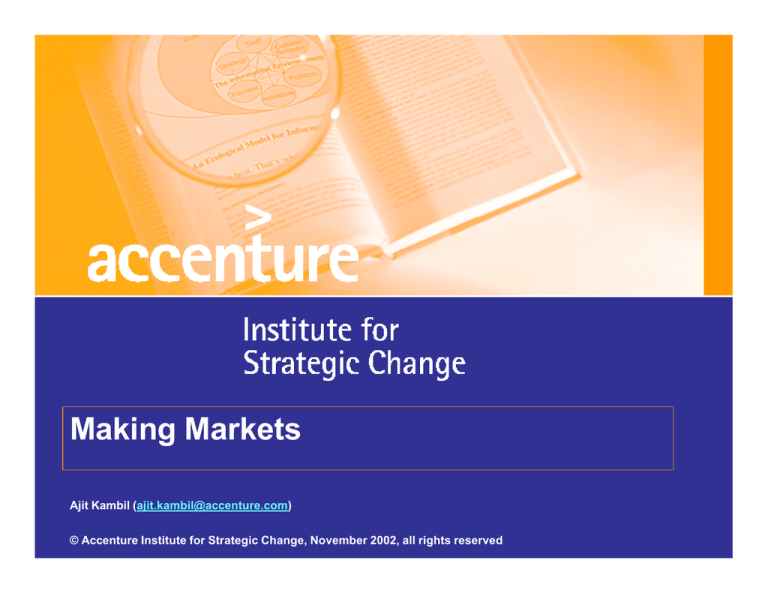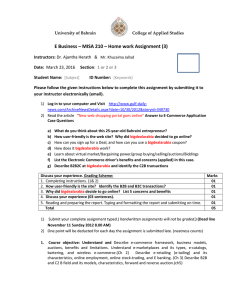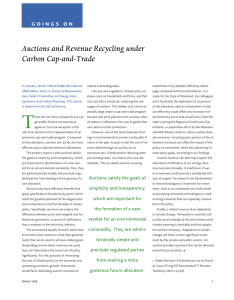
Making Markets
Ajit Kambil (ajit.kambil@accenture.com)
© Accenture Institute for Strategic Change, November 2002, all rights reserved
Accenture Institute for
Strategic Change (ISC)
Accenture
§
Global firm with 75,000 professionals and over U$10 billion in revenues in
outsourcing, technology, consulting services
Institute for Strategic Change
§
10 researchers focused on “business innovations” and actionable research
restarted in 1998
§
Outputs
— 4 Harvard Business Press books (3 to come)
— Numerous Harvard Business Review, Sloan Management Review, and
other articles, reports and working papers
— Custom client workshops – “kill your company simulations”
In 1776 Adam Smith published
a revolutionary idea…
§
§
§
§
…the invisible hand of
markets was the best way to
increase individual and
national wealth
Making Markets lays out an
agenda, and strategies for
managers and researchers
to seize the value of markets
and auctions and lead with
the “invisible hand”
Few universities teach
students how to design and
participate in markets
Learn more at
www.makingmarkets.ORG
Outline
The eMarkets Imperative: Strategic Applications
Designing Markets and Auctions
Making Markets Work – Mastering Market Rules
The Future and Conclusions
The eMarkets Imperative
The Internet and
falling IT costs
enable cheaper
aggregation of
buyers and
suppliers to...
Virtualize real
markets into
eMarkets and
enable more
strategic
applications.
Capture the power
of auctions to
”socially
construct” value
and generate
insights.
B2B Markets
and Auctions
Resale
Markets
Customer
Insight
Futures &
Predictive
Markets
Knowledge
and Decision
Markets
B2B eMarkets have experienced boom and bust,
but B2B eCommerce continues to grow
…. but the volume level of B2B
transactions continues to rise, and
companies are implementing reverse
auctions and consortia and private
exchanges.
The Accenture B2B Index in
2000 illustrates the bust. Many
upstart independent trading
exchanges such as Ventro have
closed down…
450%
March 8, 2000
415%
400%
350%
300%
250%
200%
150%
January 4, 1999
100%
January 22, 2001
95%
100%
50%
Source: Accenture B2B Index
Ja
nu
ary
-01
Oc
tob
er00
Ju
ly00
Ap
ril-0
0
Ja
nu
ary
-00
Oc
tob
er99
Ju
ly-9
9
Ap
ril-9
9
Ja
nu
ary
-99
0%
Reverse Auctions in B2B are a major
source of savings …
Sector:
Commodity:
Food distribution
Frozen vegetables
Saving (on starting price) :
17.01
%
Starting price
eProcurement promises tremendous
savings beginning with:
• auctions for direct materials
• negotiated catalog purchases of
MRO
Closing price
11:52:48
12:00:00
12:07:12
12:14:24
12:21:36
12:28:48
12:36:00
12:43:12
Reverse auctions can be applied
to a wide range of goods
Results from auction research study: % saving versus
historic cost
37%
PC consumables
30%
Staionery
22%
Foodstuff
Couriers
Foodstuff
6%
Chemicals
5%
Eng. Products
3%
0%
PC consumables
Staionery
10%
Couriers
Chemicals
Eng. Products
20%
30%
40%
50%
Source: Accenture sponsored study by Alan Smart of the Cranfield Institute
found about 19% savings on average in 2000
Communities will increasingly specialize reverse
auctions to products or industries
§
§
§
§
Servador is a New York based company for sourcing print services.
Weathered the dot com flameout by successfully introducing auctions
and specializing them for sourcing print services
Servador stays ahead of the competition by :
— Specializing the interface to print buyers who can access auctions and
other print procurement services directly from their desktop
— Providing ways to accurately specify print requirements online to
vendors
— Providing tools to multiple users in a buyer organization to track and
comment on jobs
— Providing tools to manage suppliers and archive jobs
— Integrating to existing eProcurement software
— Enabling Internet Print on Demand
By focusing on one horizontal market – Servador can build best in class
solutions and accumulate critical assets to compete.
B2B Markets are working to provide more
services for supply chain coordination
Marketplace Emerging Business Capabilities
Portal
Security
Permissioning
Enterprise Application Integration (EAI) Layer
CRM
Sales Order
Management
Configuration
Pricing
Personalization
Content
Community
Collaborative
Collaborative
Design
Design
Demand
Demand
Forecasting
Forecasting
Customers
Supply Chain
Management
Planning &
Scheduling
Browser based
eProcurement tool
Supply
Supply Chain
Chain
Planning
Planning
Sourcing
Sourcing &&
Supplier
Supplier
Management
Management
Order
Order
Management
Management
Other
Other
Marketplaces/
Marketplaces/
Exchanges
Exchanges
Fulfillment
Fulfillment &&
Logistics
Logistics
Procurement Transactions
Auction/Exchanges
Sellers
Reporting &
Decision Support
Financial Services
Credit
ePayments/Tax
Risk Management
Financial Reporting
Billing & Settlement
TBD
Sell Side
Commerce
Servers
Legacy Order
Management/
Planning
Applications
Companies will participate in a portfolio
of electronic markets
ChemConnect
Elemica
MyAccount
@Dow
Dow
1:1
Omnexus
Sourcing,
pricing
Production
Contract
fulfillment
Non-production
SciQuest
Dow
e-Mart
Direct Connection
Private Exchange
Consortium eMarket
TradeRanger
ZoneTrader
Buy
Sell
Independent eMarket
(w/equity position)
eMarkets are also becoming critical platforms
for B2B transactions across industries
2
3
1
•
•
Novopoint is a neutral B2B
hub that connects buyers
and sellers of food and
beverage ingredients,
packaging and related
services
Foodtrader.com is a
marketplace and eProcurement solution for
the food and agriculture
industry.
•
•
Transora was founded by
•
50 leading consumer
products companies
Board of Directors includes: •
– Earthgrains
– Coca-Cola
– Kraft Foods
– Procter & Gamble
– Unilever
– Diageo
– Grocery Manufacturers
of America
GlobalNetExchange is an
eMarket formed by
leading retailers
Including
– Carrefour
– Kroger
– Metro AG
– Sainsbury
– Coles Myer
– Pinault-PrintempsRedoute
– Sears
Electronic Resale Markets are a growing
market application
Site
Description
n Auction based market place founded in 1995
n 45 million subscribers in March 2002
n 54.9 million subscribers by October 2001
n Rapidly international expansions and diversification
n 2002 gross merchandise sales on eBay is expected to
exceed US$13 billion
n eBay motors ($3.8 billion)
n Computers ($1.6 billion)
n Consumer Electronics ($1.4 billion)
n Books/Movies/Music ($1.2 billion)
n Sports ($1.0 billion)
n Has used auctions since the 1930s to dispose of assets
n Focused mainly on business to business auction –
property, plant and equipment assets
nProvider of business-to-business eCommerce services for
participants in the medical products, supplies and equipment
industry
nSite functionality includes online auctions of used,
refurbished, and surplus equipment
Resale markets cannot be ignored
•
During the dot com bust the liquidity of resale
markets undermined new product sales of new
equipment vendors leading to major write-offs in
new product inventory
•
Resale markets should be factored into
forecasting and supply chain planning
•
Resale markets should be factored into post sales
services and support
Companies should increasingly have an
eBay or resale market strategy
§
§
§
§
§
Clearance – Time is money and many high
technology products are perishable
Resale - Accelerate upgrades while reaching new
customers and driving new growth
Customer Insights - Product demand, pricing and
customer preferences
Fashions and Nostalgia – Nissan 350z, the mini are
hot products
B2b – New channels to small businesses
Accenture provides a Connection to eBay service, as do
other companies
Auctions can also be used to
generate customer insights
Auctions can be used to discover the users’ willingness
to pay and the products demand curve
Demand information from auctions can
be leveraged for dynamic merchandizing
Use the
auction
data to
fixed price
offer for a
similar
scanner at
$10 above
previous
median
price
..and to ration supply to get higher
prices
Limit supply
and achieve
a higher
price per
unit
Leveraging auctions to strategically price will be
critical in an increasingly competitive economy
Dynamic pricing will also be used
to manage supply constraints....
High End Computers
1,975
1,925
Dell
1,875
Buy.Com
1,825
NECX
1,775
CompUSA
1,725
1,675
6/1/99
6/15/99
6/29/99
7/13/99
7/27/99
Dell, the dominant retailer illustrates peak load pricing adjusting prices up
and down to manage supply constraints and encourage buyers to buy built
to plan versus built to order.
All sellers also demonstrate clearance pricing given the short product
lifecycle.
Futures Markets will expand
§ Futures markets have been applied to transfer risk between different
buyers or sellers and hedge against price volatilities.
§ Delta - $140 m in third quarter 2000 by hedging airline fuel against heating
oil futures.
§ eMarkets enable the creation of futures markets in different ways
— Enron made futures markets and took positions in those markets
— Its early trading success derived from its risk management and from
having detailed information across the value chain
— Yet self-regulation proved to be its undoing – markets require
regulation and transparency and Enron’s off-balance sheet
transactions led to loss of confidence in EnronOnline. The company
filed for bankruptcy in Dec. 2001 and trading operations were sold to
UBS Warburg in January 2002
— In contrast ChemConnect acts as a platform for different companies to
trade chemical futures contracts.
Markets can also be applied to
Prediction Problems
§ Markets aggregate multiple opinions about the
§
future. Stock markets reflect sentiments about
future earnings
Charles Plott used electronic markets to
generate sales forecasts at Hewlett Packard.
— Sales forecasts through markets have proved
to be better predictors
§ Hollywood Stock Exchange provides a trading
exchange for ideas, actors, movies etc.
Pennock (et.al) show it to be a better predictor
than polls.
Newsfutures.com illustrates an
artificial market for prediction
Internal e-markets can be used to support
resource allocation
Internal
trading of
emissions
at BP
helps find
the
cheapest
ways to
reduce
emissions
Efficient Knowledge and Intellectual Property
markets represent a key opportunity
§ Yet2.com – trades patents
§ Exp, Keen – trades information e.g questions and
answers
§ eLance – market for job opportunities
§ Knexa – internal markets for knowledge
§ IntellectExchange – Access to expert consultants
§ These applications have not yet taken off – but there
remains a large opportunity in knowledge management
– specifically efficient elicitation
“The Devil’s in the Details”
Dynamic Pricing
eMarket Applications
Designing Markets and Auctions
Making Markets Work – Mastering Market Rules
The Future and Conclusions
Designing markets is not easy –
Managers confront many choices
§ The Auction Model – English, Dutch,Double
§
§
§
§
§
§
§
etc.
Bidders – The Number, Who - Pre-qualified or
Not
The auction inventory/units offered
Product description/representation method
The duration, time and speed of the auction
The rating mechanisms
Fixed price and variable price components
Bidder feedback etc.
Such as designing basic and trade
context processes
Product
Representation
Regulation
Risk Mgt
Mgty
Dispute
Resolution
Trade Context
Processes
Communications
Search
Valuation
Logistics
Payment
&
Settlements
Authentication
Basic Trade
Processes
Market Makers have not built integrated solutions to drive down the total costs
of transactions beyond search and valuation.
Source: Doing Business in the Wired World, IEEE Computer, May 1997
The “devil’s in the details”
§ Some Lessons from B2B reverse auctions..
— Pre-qualify all the bidders
— Limit bidders to less than 10
— Start the auction at a fraction over previous
best prices
— Bidders are anonymous to each other to limit
collusion
— Flexible stopping rules
— Train all bidders to the bidding process
Some consumer auction design
results
§ Accenture research on thousands of eBay
§
§
auctions found a negative rating had a
disproportionate negative effect on price.
Consumers do not account for fixed price
components well: $10 vs $5 shipping charges.
Pictures matter – but the impact is still
indeterminate
“Market Rules”
The eMarkets Imperative:Strategic Applications
Dynamic Pricing
Designing Markets and Auctions
Making Markets Work – Mastering Market Rules
The Future and Conclusions
There are a few key market rules
for success
§
§
§
Recognize electronic markets disrupt the status quo
among buyers-sellers and existing market makers
Successful electronic market initiatives must:
— Create real value in exchange processes
— Create a win-win-win between buyers, sellers and
market makers
— Subsidize adoption carefully to achieve liquidity quickly
— Lower the costs of transitioning and inter-connection to
new markets
— Account for the bounded rationality, attention and
cognitive capabilities of users
We see many markets failing to meet these challenges
Value is migrating away from
search
Product
Representation
Regulation
Risk Mgt
Mgty
Dispute
Resolution
Trade Context
Processes
Communications
Search
Valuation
Logistics
Payment
&
Settlements
Authentication
Basic Trade
Processes
Market Makers have not built integrated solutions to drive down the total costs
of transactions beyond search and valuation.
Source: Doing Business in the Wired World, IEEE Computer, May 1997
Creating wins and liquidity
§
§
For a new market to be adopted all parties - buyers,
sellers and intermediaries must have a clear win.
— Any increase in exchange process costs must be
cross subsidized away
Electronic Markets benefit from Increasing Returns to
Scale - More Users, More Value
— Critical Mass is required quickly to sustain buyer or
supplier interest in the market and create liquidity
— Subsidize or ally with key suppliers or buyers first to
form the market – Exostar, Covisint, Transora and
other consortium exchanges represent attempts to
generate liquidity
— The paradox of exchanges is that consortia members
want low costs for trading – yet high valuations for
markets. This is unsustainable – many markets will be
non profit, shared service platforms.
Map the integration challenges
Financial
Services Provider
Other Exchanges
Logistics Provider
Marketplace
Buying
Organization
Selling
Organization
Value Added
Services
Hosted Infrastructure
Services
Supplier
Order
Mgmt
Desktop
Procurement
Transaction Engine
Enterprise
Systems
Enterprise
Systems
Plan & Manage the Enterprise
EDI VAN / ETN
Figure 4: eMarket Integration Points
Leverage Integration hubs and pre-built
connectors for effective implementation
Company X
System a
eMarket 1
System b
eMarket 2
System c
eMarket 3
System d
Legacy Systems
Company X
Company X
Company X
System a
System a
System a
eMarket 1
System b
eMarket 1
eMarket 1
System b
eMarket 2
System c
System b
eMarket 2
eMarket 3
eMarket 3
eMarket 3
System d
System d
Ad Hoc Integration
eMarket 2
System c
System c
System d
Common
System
Internal and External Integration Hubs
Common System with External Integration Hub
Figure 5: Basic Integration Strategies
“The Next Wave”
Dynamic Pricing
The eMarkets Imperative:Strategic Applications
Designing Markets and Auctions
Making Markets Work – Mastering Market Rules
The Future and Conclusions
Future eMarkets will shift to..
§ Consolidate toward all-in-one markets
§ Hosted eMarkets
§ Complex decision support to conserve
attention
All-in-one Markets Provide Buyers with
Choice of Transaction Mechanisms
Transaction
Based
Exchange
Mechanisms
Spot Market
Bulletin Board
Seller Auction
66% of Companies Surveyed
Use More Than 1 Sales Mechanism
Real Time Catalog
Static Catalog
Price Tailored
4+ Mechanisms = 10%
(31 companies)
3 Mechanisms = 20%
(63 companies)
Product Tailored
3
Buyer Auction
4+
Reverse Market
Barter
Bundled
Negotiation
2
Continuous
1 Mechanism = 34%
Replenishment
Process Integration/
Partnering
Relationship
Based
Referral
1
2 Mechanisms = 36%
(118 companies)
(108 companies)
All-in-One Markets are a corollary to the
Malone,Yates and Benjamin hypotheses
High
Operational Risks
Integration
Effect
Al
l-
in
-O
ne
Hierarchy
Ma
rk
ets
Market
Brokerage
Effect
Low
Low
High
Sourcing Risks
All-in-One Markets in the Intersection of eCommerce Effects
Hosted Markets
§ Markets will be provided as ASP services
§
§
remotely
Managers will assemble components as
required
For example @themoment, MOAI provide
auction services as a remote hosted
application.
Complex Decision Support
§ Attention is the scarcest resource in the new
§
§
§
economy
Markets demand more attention
Agents will be created to reduce attention
requirements and embed business rules –
these have been among the most successful
agents to date
Multi-attribute auctions may reduce the
individual attention requirement’s to evaluate
alternatives but good decision support will be
essential to help users articulate their needs.
Overall Conclusions
§
§
§
§
§
§
Electronic markets and auctions are here to stay and create
value in a number of different areas:
— B2B trading and coordination, Resale, Risk Management,
Predictions, Decision Making and Knowledge Management
But designing and implementing markets is not easy and these
efforts are still in their infancy.
New opportunities lie in internal applications of markets
Future markets for most goods and services will:
— Offer multiple transaction mechanisms - one size does not fit
all
— Incorporate more intelligent agent based decision support
— And will be delivered in many different ways
To succeed in the market space managers will have to learn how
to bid and participate effectively in markets
B-schools should support effective market design and
participation by modifying curricula to adapt to auctions




